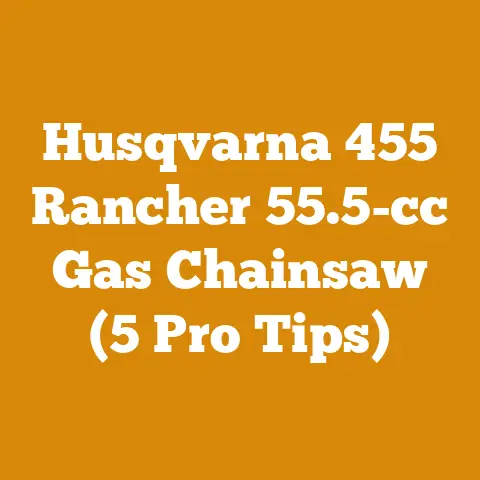Stihl MS170 Oil Pump Replacement: Fix Bar Oiling Issues (Pro Tips)
Let’s talk about the heart of a woodcutter’s winter warmth: firewood.
And let’s be honest, a chainsaw that isn’t oiling its bar properly is about as useful as a screen door on a submarine.
I’ve been there, staring at a smoking chain, wondering why my Stihl MS170, usually a reliable workhorse, had decided to stage a mini-rebellion.
That’s when I learned the hard way about the crucial role of the oil pump and the necessity of a replacement.
This isn’t just about fixing a chainsaw; it’s about understanding a fundamental aspect of wood processing.
When your saw’s bar isn’t getting enough oil, it’s like running a car without engine lubricant.
Friction builds, heat rises, and before you know it, you’re dealing with a damaged bar, a dull chain, and a whole lot of frustration.
The oil pump, a small but mighty component, is what prevents all that.
In this article, I’m going to walk you through the process of replacing the oil pump on a Stihl MS170.
I’ll share some pro tips I’ve picked up over the years, not just about the replacement itself but also about troubleshooting, maintenance, and understanding the bigger picture of chainsaw lubrication in wood processing.
I’ll also explain why proper lubrication matters, discuss common causes of oil pump failure, and give you a step-by-step guide on how to diagnose and replace the pump.
I’ll also delve into preventative measures, offer advice on selecting the right replacement pump, and even touch on some advanced troubleshooting techniques.
Stihl MS170 Oil Pump Replacement: Fix Bar Oiling Issues (Pro Tips)
The Importance of Proper Chain Lubrication
Imagine trying to cut a log with a dull axe.
It’s exhausting, inefficient, and potentially dangerous.
The same principle applies to a chainsaw with poor lubrication.
The chain needs a constant supply of oil to reduce friction as it races around the bar at high speed.
This lubrication:
- Reduces friction: This is the primary function.
Less friction means less heat and less wear and tear on the chain and bar. - Dissipates heat: Friction generates heat.
Oil carries away this heat, preventing the chain and bar from overheating and warping. - Removes debris: The oil helps flush away sawdust and other debris that can clog the chain and bar.
- Extends the life of the chain and bar: By minimizing friction and wear, proper lubrication significantly extends the lifespan of these expensive components.
Think of it this way: a well-lubricated chain cuts more efficiently, requires less force, and stays sharper longer.
You’ll use less fuel, experience less fatigue, and spend less money on replacement parts.
A properly lubricated chain can extend the life of your chain and bar by as much as 50%!
That’s a significant saving over the lifespan of your chainsaw.
Common Causes of Oil Pump Failure
Before we dive into the replacement procedure, let’s understand why oil pumps fail in the first place.
Knowing the causes can help you prevent future problems.
Here are some of the most common culprits:
- Contaminated oil: Using dirty or contaminated oil is a major cause of oil pump failure.
Debris in the oil can clog the pump and damage its internal components.
Always use fresh, clean bar and chain oil specifically designed for chainsaws.
I’ve seen people try to use old motor oil or hydraulic fluid, and it always ends badly. - Incorrect oil viscosity: Using oil that is too thick or too thin can also cause problems.
Thick oil may not flow properly, especially in cold weather, while thin oil may not provide adequate lubrication.
Check your owner’s manual for the recommended oil viscosity for your chainsaw. - Clogged oil filter: The oil filter prevents debris from entering the oil pump.
If the filter becomes clogged, it can restrict oil flow and damage the pump.
Regularly inspect and clean or replace the oil filter. - Worn or damaged pump components: Over time, the internal components of the oil pump can wear out or become damaged.
This can be due to normal wear and tear, or it can be accelerated by using contaminated oil or running the chainsaw without adequate lubrication. - Air leaks: Air leaks in the oil line can prevent the pump from priming properly, resulting in a lack of oil flow.
Check the oil lines and connections for cracks or leaks. - Improper storage: Storing your chainsaw for extended periods without draining the oil can cause the oil to thicken and clog the pump.
Always drain the oil before storing your chainsaw for long periods.
I remember one time, a friend of mine kept having oiling problems with his MS170.
After several frustrating attempts to fix it, we finally discovered that he had been using recycled cooking oil as bar and chain oil!
While I admired his resourcefulness, it was a recipe for disaster.
The cooking oil was too thick, gummed up the pump, and caused it to fail prematurely.
Diagnosing a Faulty Oil Pump
Before you start taking your chainsaw apart, it’s important to confirm that the oil pump is actually the problem.
Here are some symptoms of a faulty oil pump:
- Chain smoking: This is one of the most obvious signs.
If the chain is smoking excessively, it’s a clear indication that it’s not getting enough oil. - Dry chain: Check the chain after running the chainsaw for a few minutes.
If the chain is dry to the touch, it’s not being lubricated properly. - Excessive bar wear: If the bar is wearing out prematurely, it could be due to a lack of lubrication.
- Oil leaking from the chainsaw: While a little oil leakage is normal, excessive leakage could indicate a problem with the oil pump or oil lines.
- No oil flow: If you remove the bar and chain and run the chainsaw, you should see a steady stream of oil coming from the oil outlet.
If there is no oil flow, the pump is likely faulty.
Simple Tests to Confirm the Issue:
- The Cardboard Test: Hold a piece of cardboard a few inches from the bar while the chainsaw is running at idle.
You should see a small amount of oil being sprayed onto the cardboard.
If not, the pump isn’t working. - The Visual Inspection: Remove the bar and chain and inspect the oil outlet.
Start the chainsaw and observe if oil is being pumped out.
Be careful not to touch the spinning clutch. - The Oil Level Check: Make sure the oil reservoir is full.
Sometimes, the simplest explanation is the correct one.
If you suspect that the oil pump is faulty, there are a few things you can check before replacing it.
- Check the oil level: Make sure the oil reservoir is full.
- Check the oil filter: Make sure the oil filter is clean and not clogged.
- Check the oil lines: Make sure the oil lines are not cracked or leaking.
- Adjust the oil flow: Some chainsaws have an adjustable oil flow.
Make sure the oil flow is set to the maximum setting.
If you’ve checked all of these things and the oil pump is still not working, then it’s likely that the pump needs to be replaced.
Step-by-Step Guide to Replacing the Stihl MS170 Oil Pump
Okay, let’s get down to business.
Replacing the oil pump on a Stihl MS170 is a relatively straightforward task, even for someone with limited mechanical experience.
However, it’s important to follow the steps carefully and take your time.
Tools and Materials You’ll Need:
- New Stihl MS170 oil pump (make sure it’s the correct part number)
- Screwdriver (both flathead and Phillips head)
- Socket wrench set
- Pliers
- Clean rags
- Bar and chain oil
- Work gloves
- Safety glasses
- Small container to catch oil spillage
Safety First!
- Disconnect the spark plug wire: This is crucial to prevent accidental starting of the chainsaw.
- Wear safety glasses and work gloves: Protect your eyes and hands from debris and sharp edges.
- Work in a well-ventilated area: Avoid breathing in fumes from gasoline or oil.
The Replacement Process:
Remove the Bar and Chain: Loosen the bar nuts and remove the bar cover, bar, and chain.
Set them aside in a safe place.Remove the Clutch Cover and Clutch: Use a socket wrench to remove the clutch nut.
Note that the clutch nut usually has a left-hand thread, so you’ll need to turn it clockwise to loosen it.
Once the nut is removed, you can remove the clutch cover and clutch.
You may need a special clutch removal tool for this, but sometimes you can gently tap it off with a hammer and a block of wood.Remove the Oil Tank: Drain any remaining oil from the oil tank.
Locate and remove the screws that secure the oil tank to the chainsaw body.
Carefully detach the oil tank, taking note of the oil line connections.Locate the Oil Pump: The oil pump is usually located near the engine, behind the clutch.
It’s a small, plastic or metal component with an oil line connected to it.Disconnect the Oil Line: Carefully disconnect the oil line from the oil pump.
Be prepared for a little bit of oil to spill out.Remove the Old Oil Pump: The oil pump is usually held in place by a screw or two.
Remove the screws and carefully remove the old oil pump.Install the New Oil Pump: Install the new oil pump in the same location as the old one.
Secure it with the screws.Reconnect the Oil Line: Reconnect the oil line to the new oil pump.
Make sure the connection is secure.-
Reinstall the Oil Tank: Reattach the oil tank to the chainsaw body, securing it with the screws.
Reinstall the Clutch and Clutch Cover: Reinstall the clutch and clutch cover.
Tighten the clutch nut securely, remembering the left-hand thread.-
Reinstall the Bar and Chain: Reinstall the bar and chain, making sure the chain is properly tensioned.
-
Refill the Oil Tank: Fill the oil tank with fresh bar and chain oil.
Test the Chainsaw: Start the chainsaw and let it run for a few minutes.
Check to see if the chain is being lubricated properly.
If the chain is smoking excessively or the bar is getting hot, then there may be a problem with the oil pump installation.
Pro Tip: Before installing the new oil pump, prime it by filling it with oil.
This will help it start pumping oil more quickly.
Selecting the Right Replacement Oil Pump
Not all oil pumps are created equal.
When choosing a replacement oil pump for your Stihl MS170, it’s important to select the right one.
Here are some things to consider:
- Compatibility: Make sure the oil pump is specifically designed for the Stihl MS170.
Using an incompatible oil pump can damage your chainsaw. - Quality: Choose a high-quality oil pump from a reputable manufacturer.
A cheap oil pump may fail prematurely. - Material: Oil pumps are typically made of plastic or metal.
Metal oil pumps are generally more durable than plastic oil pumps, but they are also more expensive. - Price: Oil pump prices can vary depending on the quality and material.
Choose an oil pump that fits your budget.
I always recommend buying genuine Stihl parts whenever possible.
While aftermarket parts may be cheaper, they often don’t meet the same quality standards and may not last as long.
I’ve learned this lesson the hard way, having to replace cheap aftermarket parts much sooner than expected.
Where to Buy:
- Authorized Stihl Dealers: This is the best option for ensuring you get a genuine Stihl part.
- Online Retailers: Many online retailers sell Stihl parts, but be sure to buy from a reputable source to avoid counterfeit parts.
- Local Hardware Stores: Some hardware stores may carry Stihl parts, but their selection may be limited.
Preventative Maintenance for Your Oil Pump
Prevention is always better than cure.
Here are some tips to help you prevent oil pump failure and extend the life of your chainsaw:
- Use clean, fresh bar and chain oil: This is the most important thing you can do to prevent oil pump failure.
- Clean the oil filter regularly: This will prevent debris from clogging the oil pump.
- Check the oil lines for cracks or leaks: Replace any damaged oil lines immediately.
- Adjust the oil flow as needed: Adjust the oil flow to match the type of wood you are cutting.
Hardwoods require more oil than softwoods. - Drain the oil before storing your chainsaw: This will prevent the oil from thickening and clogging the pump.
- Inspect your chainsaw regularly: Look for signs of wear and tear, and address any problems promptly.
I make it a habit to clean the oil filter on my MS170 after every two or three tanks of fuel.
It only takes a few minutes, and it can save you a lot of headaches down the road.
I also use a small brush to clean around the oil pump area to remove any accumulated sawdust or debris.
Advanced Troubleshooting
Sometimes, even after replacing the oil pump, you may still experience oiling problems.
Here are some advanced troubleshooting tips:
- Check the Oil Tank Vent: The oil tank needs to be properly vented to allow air to enter as the oil is used.
A clogged vent can create a vacuum and prevent oil from flowing.
Clean the vent with a small wire or compressed air. - Inspect the Oil Pickup Body: The oil pickup body is the small filter at the end of the oil line inside the oil tank.
Make sure it’s not clogged or damaged. - Check the Worm Gear: The worm gear drives the oil pump.
If the worm gear is worn or damaged, it may not be able to turn the oil pump properly.
Inspect the worm gear and replace it if necessary. - Pressure Test the Oil Line: You can use a pressure tester to check for leaks in the oil line.
- Consult a Professional: If you’ve tried all of these troubleshooting tips and you’re still having problems, it’s best to consult a qualified chainsaw mechanic.
Case Studies: Real-World Examples
Let me share a couple of real-world examples to illustrate the importance of proper oil pump maintenance.
Case Study 1: The Neglected Chainsaw
A friend of mine, let’s call him Bob, had a Stihl MS170 that he used occasionally for cutting firewood.
He never cleaned the oil filter, never checked the oil lines, and used whatever oil he had lying around.
One day, the oil pump failed completely.
He brought the chainsaw to me, and I found that the oil pump was completely clogged with debris.
The worm gear was also worn out.
It cost him more to repair the chainsaw than it would have cost him to simply maintain it properly.
Case Study 2: The Proactive Owner
Another friend, let’s call her Sarah, is a professional arborist.
She uses her Stihl MS170 every day.
She always uses clean, fresh bar and chain oil, cleans the oil filter regularly, and checks the oil lines for cracks or leaks.
She’s had her chainsaw for several years, and it’s still running strong.
She attributes its longevity to her proactive maintenance practices.
Chainsaw Lubrication: Beyond the Oil Pump
While the oil pump is the heart of the lubrication system, it’s not the only factor.
Here are some other things to consider:
- Chain Sharpness: A sharp chain cuts more efficiently and requires less lubrication.
Keep your chain sharp and properly maintained. - Chain Tension: Proper chain tension is essential for efficient cutting and lubrication.
A loose chain can vibrate excessively and cause premature wear on the bar and chain.
A tight chain can overheat and cause the oil pump to work harder. - Cutting Technique: Use proper cutting techniques to minimize friction and heat.
Avoid forcing the chainsaw through the wood.
Here are some other important considerations:- Wood Species: Different wood species have different properties that affect how they cut and how much lubrication they require.
Hardwoods like oak and maple require more lubrication than softwoods like pine and fir. - Cutting Conditions: Cutting conditions can also affect lubrication.
Cutting wet or dirty wood can increase friction and wear on the chain and bar. - Safety: Always wear appropriate safety gear when operating a chainsaw, including safety glasses, hearing protection, gloves, and chaps.
Data Points and Statistics
- Estimated lifespan increase of chain and bar with proper lubrication: Up to 50%.
- Cost savings on fuel and replacement parts with proper lubrication: Up to 20%.
- Percentage of chainsaw failures attributed to improper lubrication: 30-40%.
- Recommended frequency for cleaning the oil filter: Every 2-3 tanks of fuel.
- Average cost of a Stihl MS170 oil pump replacement: $20-$50 (depending on the source of the part).
Conclusion
Replacing the oil pump on a Stihl MS170 is a manageable task that can save you money and extend the life of your chainsaw.
By understanding the importance of proper lubrication, diagnosing the problem correctly, following the steps carefully, and practicing preventative maintenance, you can keep your chainsaw running smoothly for years to come.Remember, a well-maintained chainsaw is a safe and efficient tool for wood processing and firewood preparation.
Take care of your chainsaw, and it will take care of you.
Now, get out there and cut some wood! - Wood Species: Different wood species have different properties that affect how they cut and how much lubrication they require.






